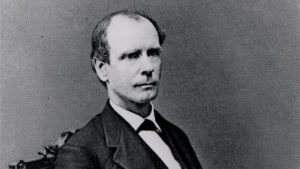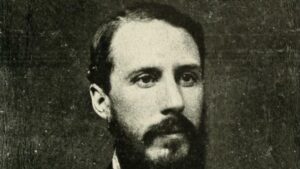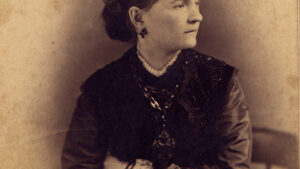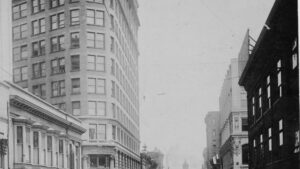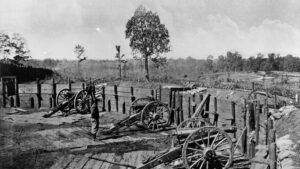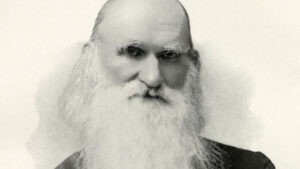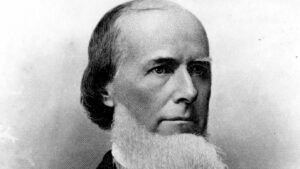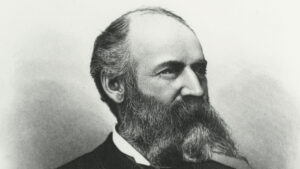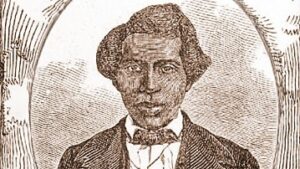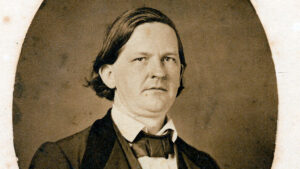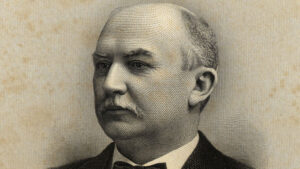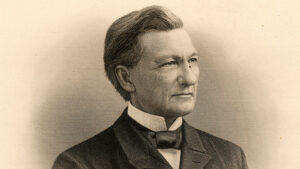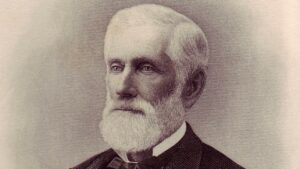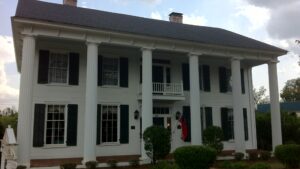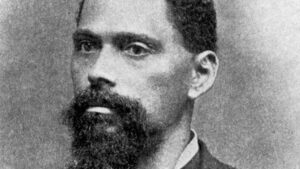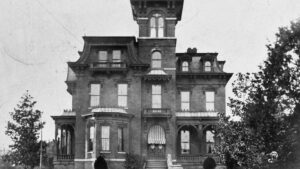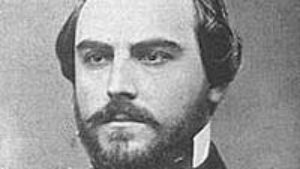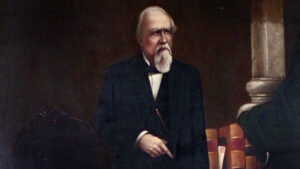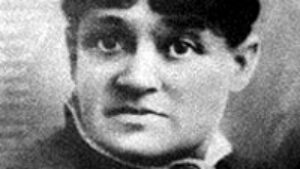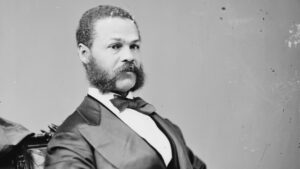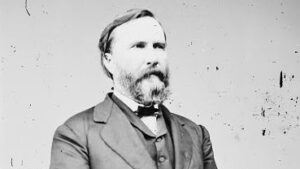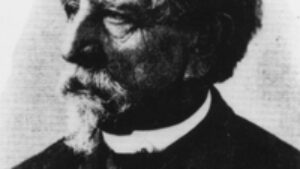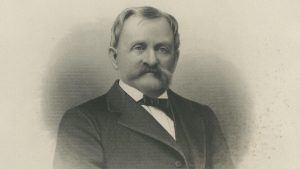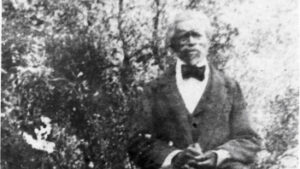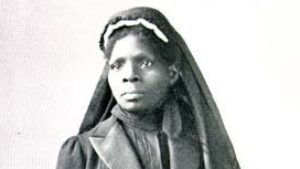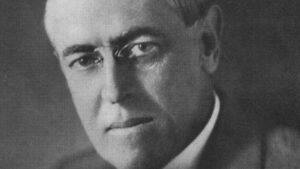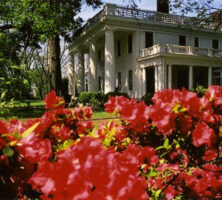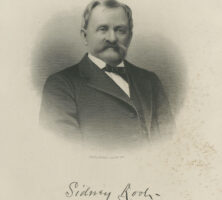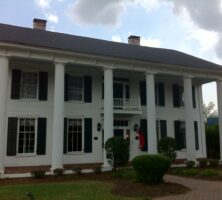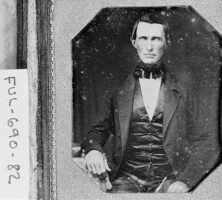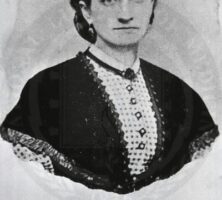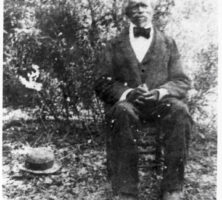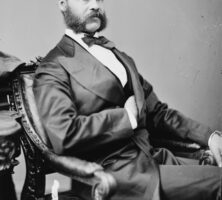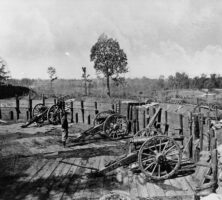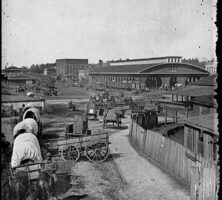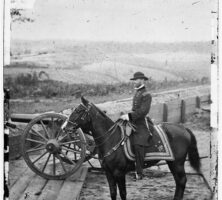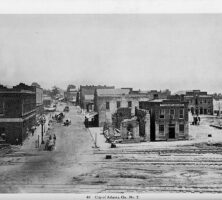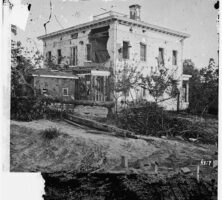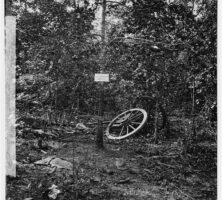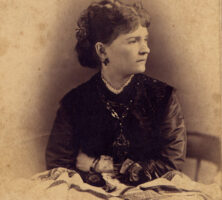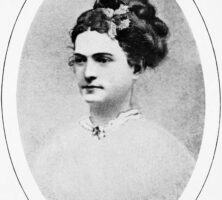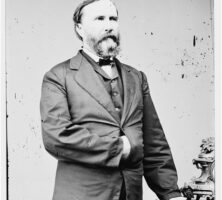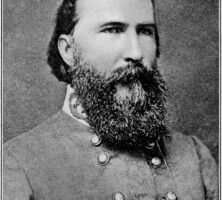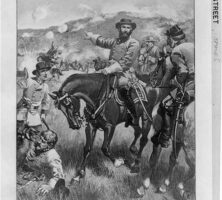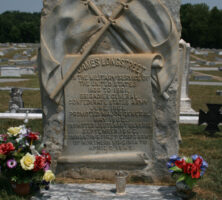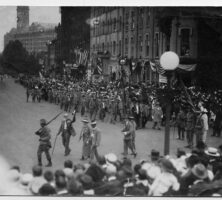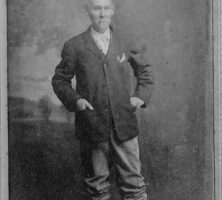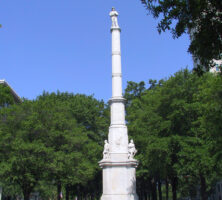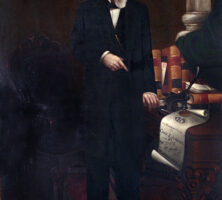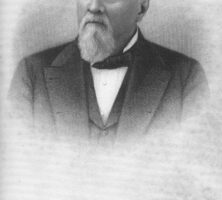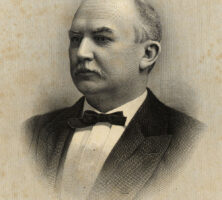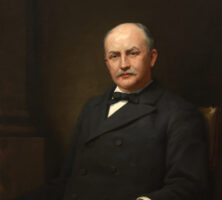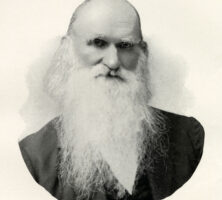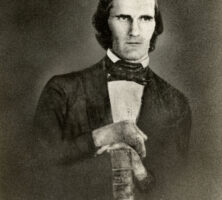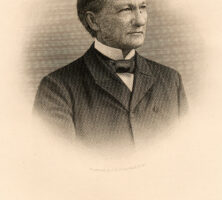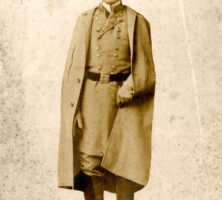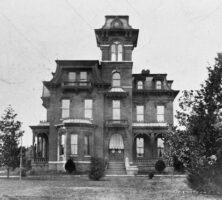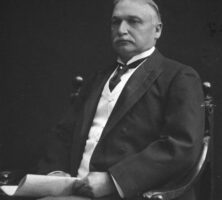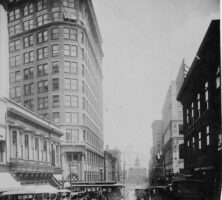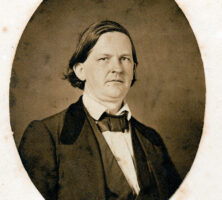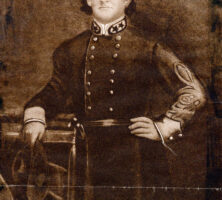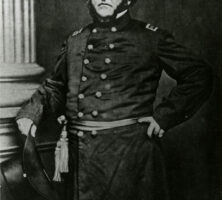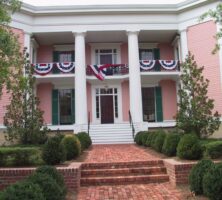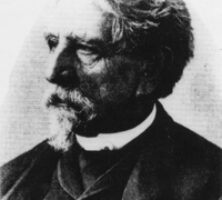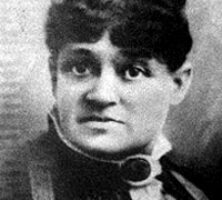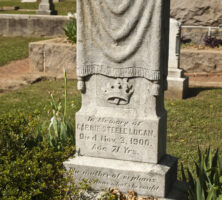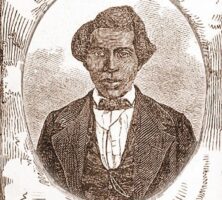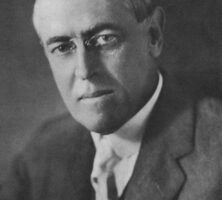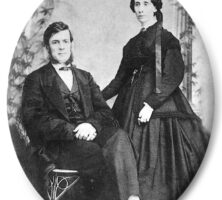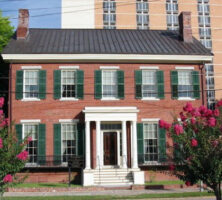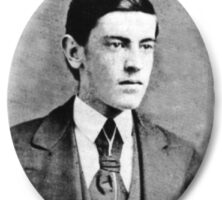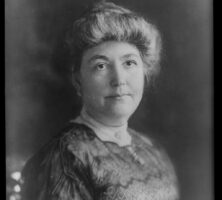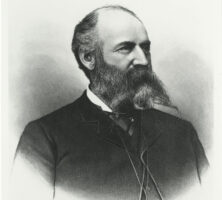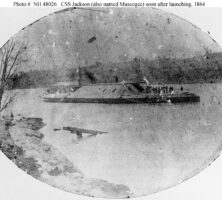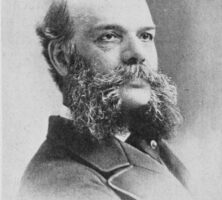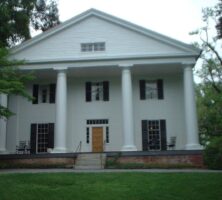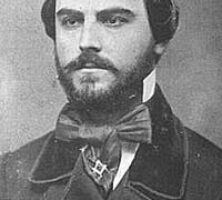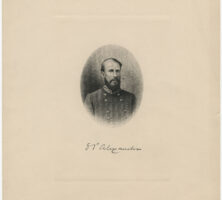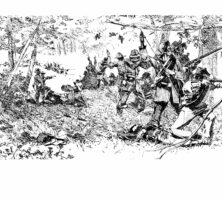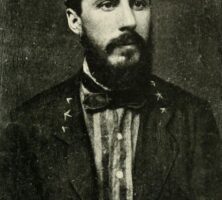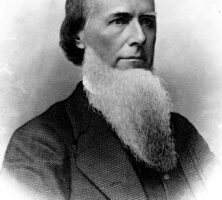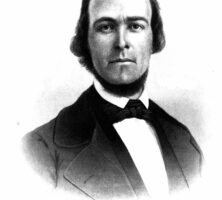The New Georgia Encyclopedia is supported by funding from A More Perfect Union, a special initiative of the National Endowment for the Humanities.
The Joshua Hill House, one of the many antebellum homes in Madison, was built around 1840 for U.S. congressman Joshua Hill, who may have convinced Union general William T. Sherman to spare the town during his March to the Sea. Today it is part of the Madison Historic District.
Courtesy of Georgia Department of Economic Development.
The New Georgia Encyclopedia does not hold the copyright for this media resource and can neither grant nor deny permission to republish or reproduce the image online or in print. Requests for permission to publish or reproduce the resource may need to be submitted to the Georgia Department of Economic Development.
Sidney Root, a prominent Atlanta businessman, was an integral part of the Confederate war effort during the Civil War. He later served as the director of the International Cotton Exposition of 1881 in Atlanta and, as park commissioner for the city, was instrumental in the building of Grant Park.
The New Georgia Encyclopedia does not hold the copyright for this media resource and can neither grant nor deny permission to republish or reproduce the image online or in print. Requests for permission to publish or reproduce the resource should be submitted to the Hargrett Manuscript and Rare Book Library at the University of Georgia.
The New Georgia Encyclopedia does not hold the copyright for this media resource and can neither grant nor deny permission to republish or reproduce the image online or in print. All requests for permission to publish or reproduce the resource must be submitted to the rights holder.
The New Georgia Encyclopedia does not hold the copyright for this media resource and can neither grant nor deny permission to republish or reproduce the image online or in print. All requests for permission to publish or reproduce the resource must be submitted to the rights holder.
The Holliday-Dorsey-Fife House in Fayetteville, designed in the Greek revival style, was built in 1855 by John Stiles Holliday, the uncle of "Doc" Holliday. The city bought the home in 1999, and following renovations, the Holliday-Dorsey-Fife House Museum opened to the public in 2003.
Image from Cdrcody
The New Georgia Encyclopedia does not hold the copyright for this media resource and can neither grant nor deny permission to republish or reproduce the image online or in print. All requests for permission to publish or reproduce the resource must be submitted to the rights holder.
Henry Burroughs Holliday, the father of Old West icon John Henry "Doc" Holliday, is pictured circa 1840. Henry Holliday served as a major in the Twenty-seventh Georgia Infantry during the Civil War.
Courtesy of Georgia Archives, Vanishing Georgia, #
ful0690-82.
The New Georgia Encyclopedia does not hold the copyright for this media resource and can neither grant nor deny permission to republish or reproduce the image online or in print. Requests for permission to publish or reproduce the resource should be submitted to the Georgia Archives.
Inspired by Florence Nightingale, Kate Cumming served as a nurse during the Civil War. She treated wounded Confederate soldiers in numerous field hospitals throughout Georgia. After the war she published a chronicle of her wartime nursing experiences.
Courtesy of National Library of Medicine
The New Georgia Encyclopedia does not hold the copyright for this media resource and can neither grant nor deny permission to republish or reproduce the image online or in print. All requests for permission to publish or reproduce the resource must be submitted to the rights holder.
Neptune Small, pictured circa 1900, was born into slave status on St. Simons Island at Retreat Plantation, which was owned by Thomas Butler King. Small accompanied King's sons to battle during the Civil War. After the war he lived as a free man on St. Simons for more than forty years.
Courtesy of Coastal Georgia Historical Society.
The New Georgia Encyclopedia does not hold the copyright for this media resource and can neither grant nor deny permission to republish or reproduce the image online or in print. Requests for permission to publish or reproduce the resource may need to be submitted to the Coastal Georgia Historical Society.
The New Georgia Encyclopedia does not hold the copyright for this media resource and can neither grant nor deny permission to republish or reproduce the image online or in print. All requests for permission to publish or reproduce the resource must be submitted to the rights holder.
Jefferson Franklin Long was the first African American from Georgia to serve in the U.S. House of Representatives. A native of Crawford County, Long was elected in December 1870 and served until March 1871.
Courtesy of Library of Congress, Prints and Photographs Division
The New Georgia Encyclopedia does not hold the copyright for this media resource and can neither grant nor deny permission to republish or reproduce the image online or in print. All requests for permission to publish or reproduce the resource must be submitted to the rights holder.
George N. Barnard made this photograph of Confederate works in Atlanta in September 1864, after Confederate troops had evacuated the city to escape Union general William T. Sherman's forces. Barnard, the official photographer for the Military Division the Mississippi, took many photographs of battlefield remains in Atlanta.
From Photographic Views of Sherman's Campaign, by George N. Barnard
The New Georgia Encyclopedia does not hold the copyright for this media resource and can neither grant nor deny permission to republish or reproduce the image online or in print. All requests for permission to publish or reproduce the resource must be submitted to the rights holder.
As the official photographer for the Military Division of the Mississippi, George N. Barnard traveled with Union general William T. Sherman's troops. This photo shows an Atlanta railroad depot in 1864, after the city's capture by Union troops.
Courtesy of Library of Congress, Prints and Photographs Division, Photgraph by George N. Barnard, #LC-B8171-2712.
The New Georgia Encyclopedia does not hold the copyright for this media resource and can neither grant nor deny permission to republish or reproduce the image online or in print. All requests for permission to publish or reproduce the resource must be submitted to the rights holder.
In this photograph, taken by George N. Barnard, Union general William T. Sherman sits astride his horse at Federal Fort No. 7 in Atlanta. Sherman's Atlanta campaign, which lasted through the spring and summer of 1864, resulted in the fall of the city on September 2.
Courtesy of Library of Congress, Prints and Photographs Division, Photograph by George N. Barnard, #LC-DIG-cwpb-03628.
The New Georgia Encyclopedia does not hold the copyright for this media resource and can neither grant nor deny permission to republish or reproduce the image online or in print. All requests for permission to publish or reproduce the resource must be submitted to the rights holder.
An Atlanta street, showing the destruction inflicted on the city by Union general William T. Sherman's troops, in 1864. The picture was taken by George N. Barnard, the official photographer for the Military Division of the Mississippi, commanded by Sherman.
From Photographic Views of Sherman's Campaign, by G. N. Barnard
The New Georgia Encyclopedia does not hold the copyright for this media resource and can neither grant nor deny permission to republish or reproduce the image online or in print. All requests for permission to publish or reproduce the resource must be submitted to the rights holder.
This photograph shows the shell-damaged Potter House in Atlanta. As the official photographer for the Military Division of the Mississippi, George N. Barnard documented in 1864-65 some of the destruction left in the wake of the Civil War.
Courtesy of Library of Congress, Prints and Photographs Division, Photograph by George N. Barnard, #LC-B8171-2717.
The New Georgia Encyclopedia does not hold the copyright for this media resource and can neither grant nor deny permission to republish or reproduce the image online or in print. All requests for permission to publish or reproduce the resource must be submitted to the rights holder.
The death site of Union general James B. McPherson was photographed by George N. Barnard after the Civil War ended. McPherson was killed on horseback during the Battle of Atlanta on July 22, 1864. A horse skeleton is visible in the left background.
Courtesy of Library of Congress, Prints and Photographs Division, Photgraph by George N. Barnard.
The New Georgia Encyclopedia does not hold the copyright for this media resource and can neither grant nor deny permission to republish or reproduce the image online or in print. All requests for permission to publish or reproduce the resource must be submitted to the rights holder.
Eliza Frances Andrews (pictured ca. 1879) was a writer of journals, novels, newspaper reports, botany articles and textbooks, and editorials. Her published diary, War-Time Journal of a Georgia Girl, 1864-1865, is one of the most compelling first-person accounts of the Civil War home front.
Courtesy of University of Tennessee at Chattanooga Lupton Library Special Collections
The New Georgia Encyclopedia does not hold the copyright for this media resource and can neither grant nor deny permission to republish or reproduce the image online or in print. All requests for permission to publish or reproduce the resource must be submitted to the rights holder.
Image of Eliza Frances Andrews in the War-Time Journal of a Georgia Girl, 1864-1865, one of the most compelling first-person accounts of the Civil War (1861-65) home front, published in 1908. Eliza Frances Andrews was a writer, newspaper reporter, editor, columnist, social critic, scientist, and educator. By the time of her death in 1931 in Rome, Georgia, Andrews had written three novels, more than a dozen scientific articles on botany, two internationally recognized botany textbooks, and dozens of articles, commentaries, and reports on topics ranging from politics to environmental issues.
Image from The War Time Journal of a Georgia Girl (1908)
The New Georgia Encyclopedia does not hold the copyright for this media resource and can neither grant nor deny permission to republish or reproduce the image online or in print. All requests for permission to publish or reproduce the resource must be submitted to the rights holder.
During Reconstruction, James Longstreet, pictured circa 1865, lived in New Orleans, Louisiana. Although he served as a Confederate general during the Civil War, Longstreet acquired the image of a southern traitor during the postwar years by cultivating political relationships with such prominent Republicans as U.S. president Ulysses S. Grant.
Courtesy of Library of Congress, Prints and Photographs Division, Civil War Glass Negative Collection, #LC-DIG-cwpb-06084.
The New Georgia Encyclopedia does not hold the copyright for this media resource and can neither grant nor deny permission to republish or reproduce the image online or in print. All requests for permission to publish or reproduce the resource must be submitted to the rights holder.
James Longstreet, a general during the Civil War, grew up primarily in Georgia, where from the age of nine he was raised by his uncle Augustus Baldwin Longstreet. He served as second-in-command to Robert E. Lee in the Army of Northern Virginia and in 1864 helped lead Confederate troops to victory at the Battle of Chickamauga, which was fought in north Georgia.
Image from Bradford, Gamaliel, 1863-1932
The New Georgia Encyclopedia does not hold the copyright for this media resource and can neither grant nor deny permission to republish or reproduce the image online or in print. All requests for permission to publish or reproduce the resource must be submitted to the rights holder.
Painter H. A. Ogden depicts James Longstreet leading his troops in Longstreet at Gettysburg (circa 1900). Longstreet, a Confederate general, disagreed with the tactics of his superior, Robert E. Lee, and was later blamed for the Confederacy's loss of the battle.
Courtesy of Library of Congress, Prints and Photographs Division
The New Georgia Encyclopedia does not hold the copyright for this media resource and can neither grant nor deny permission to republish or reproduce the image online or in print. All requests for permission to publish or reproduce the resource must be submitted to the rights holder.
A monument to James Longstreet, a Confederate general and Georgia politician, stands in the Alta Vista Cemetery in Gainesville, where he is buried. Longstreet lived in Gainesville, operating the Piedmont Hotel and a farm, from 1875 until his death in 1904.
Photograph by Michael Noirot
The New Georgia Encyclopedia does not hold the copyright for this media resource and can neither grant nor deny permission to republish or reproduce the image online or in print. All requests for permission to publish or reproduce the resource must be submitted to the rights holder.
Berry Benson, an Augusta resident and veteran of the Civil War, leads a 1917 review before U.S. president Woodrow Wilson in Washington, D.C. Benson carries his rifle, which he refused to surrender at the end of the war in 1865.
Courtesy of Edward J. Cashin
The New Georgia Encyclopedia does not hold the copyright for this media resource and can neither grant nor deny permission to republish or reproduce the image online or in print. All requests for permission to publish or reproduce the resource must be submitted to the rights holder.
Berry Benson, a longtime citizen of Augusta, was a Civil War veteran, cotton broker, accountant, and writer. He served as the model for the anonymous soldier standing atop the Confederate Monument in Augusta, erected in 1878 on Broad Street.
Courtesy of Edward J. Cashin
The New Georgia Encyclopedia does not hold the copyright for this media resource and can neither grant nor deny permission to republish or reproduce the image online or in print. All requests for permission to publish or reproduce the resource must be submitted to the rights holder.
The Confederate Monument in downtown Augusta bears the inscription, "No Nation Rose So White and Fair; None Fell So Pure of Crime." Four Confederate generals, including Georgian Thomas R. R. Cobb, stand around the base of the memorial, while the likeness of Augusta resident Benson Berry graces the top.
Photograph by Melinda Smith Mullikin, New Georgia Encyclopedia
The New Georgia Encyclopedia does not hold the copyright for this media resource and can neither grant nor deny permission to republish or reproduce the image online or in print. All requests for permission to publish or reproduce the resource must be submitted to the rights holder.
Charles Jones Jenkins accepts a scroll bearing the governor's seal and the motto In Arduis Fidelis (Steadfast in Adversity) in this portrait by Poindexter Page Carter. In 1872 the state presented the seal and motto to the former governor in appreciation for his resistance to the dictates of the federal government during Reconstruction.
Courtesy of Georgia Capitol Museum, University of Georgia Libraries
The New Georgia Encyclopedia does not hold the copyright for this media resource and can neither grant nor deny permission to republish or reproduce the image online or in print. All requests for permission to publish or reproduce the resource must be submitted to the rights holder.
The Georgia Platform established Georgia's conditional acceptance of the Compromise of 1850. Much of the document followed a draft written by Charles Jones Jenkins, who later served as Georgia's governor from 1865 to 1868.
The New Georgia Encyclopedia does not hold the copyright for this media resource and can neither grant nor deny permission to republish or reproduce the image online or in print. Requests for permission to publish or reproduce the resource should be submitted to the Hargrett Manuscript and Rare Book Library at the University of Georgia.
Charles Crisp, raised in Savannah, was a prominent judge and a U.S. congressman during the second half of the nineteenth century. Crisp County, located in south Georgia, is named in his honor.
From Memorial Addresses on the Life and Character of Charles Frederick Crisp
The New Georgia Encyclopedia does not hold the copyright for this media resource and can neither grant nor deny permission to republish or reproduce the image online or in print. All requests for permission to publish or reproduce the resource must be submitted to the rights holder.
Charles Crisp, a Confederate veteran from Georgia, served in the U.S. House of Representatives from 1883 until his death in 1896. During his tenure in Congress, Crisp was elected Speaker of the House from 1891 to 1895. He was the only Georgian to serve in that role between Howell Cobb, elected in 1849, and Newt Gingrich, elected in 1995.
Image from Robert Cutler Hinckley
The New Georgia Encyclopedia does not hold the copyright for this media resource and can neither grant nor deny permission to republish or reproduce the image online or in print. All requests for permission to publish or reproduce the resource must be submitted to the rights holder.
Logan Bleckley retired as chief justice of the state supreme court in 1894, at the age of sixty-seven. Interested in poetry, philosophy, and mathematics in addition to the law, Bleckley continued to study these disciplines into his later years.
Courtesy of Hargrett Rare Book and Manuscript Library, University of Georgia Libraries, Georgia Photo File.
The New Georgia Encyclopedia does not hold the copyright for this media resource and can neither grant nor deny permission to republish or reproduce the image online or in print. Requests for permission to publish or reproduce the resource should be submitted to the Hargrett Manuscript and Rare Book Library at the University of Georgia.
Logan Bleckley, a self-educated lawyer, served as both associate and chief justice of the Supreme Court of Georgia during the late nineteenth century. His opinions were circulated nationally and often contained stanzas of Bleckley's own poetry.
Courtesy of Hargrett Rare Book and Manuscript Library, University of Georgia Libraries, Georgia Photo File.
The New Georgia Encyclopedia does not hold the copyright for this media resource and can neither grant nor deny permission to republish or reproduce the image online or in print. Requests for permission to publish or reproduce the resource should be submitted to the Hargrett Manuscript and Rare Book Library at the University of Georgia.
Clement Evans, a native of Stewart County, served as a judge, state senator, soldier, and Methodist minister during his varied career. A supporter of the Confederate cause throughout his life, Evans cofounded the United Confederate Veterans and edited or authored several publications on Georgia's military history.
Courtesy of Hargrett Rare Book and Manuscript Library, University of Georgia Libraries, Georgia Photo File.
The New Georgia Encyclopedia does not hold the copyright for this media resource and can neither grant nor deny permission to republish or reproduce the image online or in print. Requests for permission to publish or reproduce the resource should be submitted to the Hargrett Manuscript and Rare Book Library at the University of Georgia.
Clement Evans, a Confederate veteran of the Civil War, voiced the foundation of Lost Cause ideology by asserting that the act of secession must be justified in order to preserve the honor of the South.
Courtesy of Hargrett Rare Book and Manuscript Library, University of Georgia Libraries, Georgia Photo File.
The New Georgia Encyclopedia does not hold the copyright for this media resource and can neither grant nor deny permission to republish or reproduce the image online or in print. Requests for permission to publish or reproduce the resource should be submitted to the Hargrett Manuscript and Rare Book Library at the University of Georgia.
The New Georgia Encyclopedia does not hold the copyright for this media resource and can neither grant nor deny permission to republish or reproduce the image online or in print. All requests for permission to publish or reproduce the resource must be submitted to the rights holder.
The Inman family donated a portion of their wealth to many charitable causes in Atlanta, including several colleges, the Confederate Soldiers' Home, Grady Memorial Hospital, and this orphanage.
Courtesy of Atlanta History Center.
The New Georgia Encyclopedia does not hold the copyright for this media resource and can neither grant nor deny permission to republish or reproduce the image online or in print. Requests for permission to publish or reproduce the resource should be submitted to the Atlanta History Center.
Hugh Inman, the youngest son of Shadrach W. Inman, sits for a portrait as a young boy. After the family moved to Atlanta in 1865, Hugh worked with his father to establish a dry goods store in the city.
Courtesy of Atlanta History Center.
The New Georgia Encyclopedia does not hold the copyright for this media resource and can neither grant nor deny permission to republish or reproduce the image online or in print. Requests for permission to publish or reproduce the resource should be submitted to the Atlanta History Center.
Four generations of the Inman family begin with (right to left) Shadrach W. Inman, Samuel M. Inman, Henry Arthur Inman, and Arthur Crew Inman. Shadrach arrived in Atlanta from east Tennessee in 1865 to join his brothers William H. and Walker P. Inman. The Inman family soon became among the most wealthy and prominent in the city.
Courtesy of Atlanta History Center.
The New Georgia Encyclopedia does not hold the copyright for this media resource and can neither grant nor deny permission to republish or reproduce the image online or in print. Requests for permission to publish or reproduce the resource should be submitted to the Atlanta History Center.
Samuel Inman, the oldest son of Shadrach W. Inman, opened a dry goods store in Augusta before becoming, along with his brother Hugh and friend Joel Hurt, an investor in railroads, streetcars, and banks in Atlanta during the 1890s.
Courtesy of Atlanta History Center.
The New Georgia Encyclopedia does not hold the copyright for this media resource and can neither grant nor deny permission to republish or reproduce the image online or in print. Requests for permission to publish or reproduce the resource should be submitted to the Atlanta History Center.
This photograph of the Atlanta National Bank (tall building, left) on Alabama Street was taken during the 1910s. Atlanta Joint Terminal Georgia Railroad Freight Depot is at the end of the street.
Courtesy of Atlanta Journal-Constitution.
The New Georgia Encyclopedia does not hold the copyright for this media resource and can neither grant nor deny permission to republish or reproduce the image online or in print. All requests for permission to publish or reproduce the resource must be submitted to the Atlanta Journal-Constitution.
The town of Austell, in Cobb County, was named for the banker Alfred Austell in honor of his work to build two branches of the Southern Railway. This photograph of Main Street in downtown Austell was taken in 1951.
Courtesy of Atlanta Journal-Constitution.
The New Georgia Encyclopedia does not hold the copyright for this media resource and can neither grant nor deny permission to republish or reproduce the image online or in print. All requests for permission to publish or reproduce the resource must be submitted to the Atlanta Journal-Constitution.
After graduation from the University of Georgia, Thomas R. R. Cobb practiced law and wrote several significant legal works, including a defense of slavery called An Inquiry into the Law of Negro Slavery in the United States of America (1858). Cobb and his brother Howell campaigned around Georgia for secession following the election of Abraham Lincoln in 1860.
Courtesy of Hargrett Rare Book and Manuscript Library, University of Georgia Libraries, Georgia Photo File.
The New Georgia Encyclopedia does not hold the copyright for this media resource and can neither grant nor deny permission to republish or reproduce the image online or in print. Requests for permission to publish or reproduce the resource should be submitted to the Hargrett Manuscript and Rare Book Library at the University of Georgia.
Thomas R. R. Cobb, an antebellum legal authority and Confederate general, was born in Jefferson County but spent most of his life in Athens. He graduated at the top of his class from the University of Georgia and in 1844 married Marion Lumpkin, the daughter of prominent judge Joseph Henry Lumpkin.
Courtesy of Hargrett Rare Book and Manuscript Library, University of Georgia Libraries, Georgia Photo File.
The New Georgia Encyclopedia does not hold the copyright for this media resource and can neither grant nor deny permission to republish or reproduce the image online or in print. Requests for permission to publish or reproduce the resource should be submitted to the Hargrett Manuscript and Rare Book Library at the University of Georgia.
Following Georgia's secession from the Union in 1861, Howell Cobb served as president of the Confederate Provisional Congress (1861-62) and a major general of the Confederate army.
Courtesy of Hargrett Rare Book and Manuscript Library, University of Georgia Libraries, Georgia Photo File.
The New Georgia Encyclopedia does not hold the copyright for this media resource and can neither grant nor deny permission to republish or reproduce the image online or in print. Requests for permission to publish or reproduce the resource should be submitted to the Hargrett Manuscript and Rare Book Library at the University of Georgia.
The Lucy Cobb Institute, a secondary school for young women in Athens, was founded in 1859 by Thomas R. R. Cobb, a prominent lawyer and proslavery writer.
Courtesy of Georgia Archives, Vanishing Georgia, # clr053.
The New Georgia Encyclopedia does not hold the copyright for this media resource and can neither grant nor deny permission to republish or reproduce the image online or in print. Requests for permission to publish or reproduce the resource should be submitted to the Georgia Archives.
The historic T. R. R. Cobb house, built in Athens in 1839, was moved to Stone Mountain in 1985. The home was returned in 2004 to Athens and situated two blocks from its original location. Restored by the Watson-Brown Foundation, the home opened in 2007 as a house museum and conference site.
Photograph by Sarah E. McKee, New Georgia Encyclopedia
The New Georgia Encyclopedia does not hold the copyright for this media resource and can neither grant nor deny permission to republish or reproduce the image online or in print. All requests for permission to publish or reproduce the resource must be submitted to the rights holder.
A railroad engineer, Lemuel Grant designed the fortifications for Atlanta during the Civil War. He also designed and built the Market (Broad) Street Bridge in 1865, and in 1882 donated 100 acres for Atlanta's first park, which is named in his honor.
Image from Atlanta And Its Builders by Thomas H. Martin
The New Georgia Encyclopedia does not hold the copyright for this media resource and can neither grant nor deny permission to republish or reproduce the image online or in print. All requests for permission to publish or reproduce the resource must be submitted to the rights holder.
Atlanta residents stroll through Grant Park in 1907. Other popular activities at the park included swimming, boating, and playing tennis.
Courtesy of Georgia Archives, Vanishing Georgia, #
ful1055-91.
The New Georgia Encyclopedia does not hold the copyright for this media resource and can neither grant nor deny permission to republish or reproduce the image online or in print. Requests for permission to publish or reproduce the resource should be submitted to the Georgia Archives.
The women of Columbus, led by Lizzie Rutherford, began to maintain the Confederate section of Linwood Cemetery shortly before the Civil War ended. Rutherford's efforts were among the earliest to foster a nostalgia for the prewar South that eventually culminated in what historians today term "Lost Cause religion."
Courtesy of Historic Linwood Foundation, Inc.
The New Georgia Encyclopedia does not hold the copyright for this media resource and can neither grant nor deny permission to republish or reproduce the image online or in print. All requests for permission to publish or reproduce the resource must be submitted to the rights holder.
Major Raphael Moses, as chief supply officer for General James Longstreet, carried out the final order of the Confederate government. He is also credited with being the first to ship and sell peaches outside of the South.
The New Georgia Encyclopedia does not hold the copyright for this media resource and can neither grant nor deny permission to republish or reproduce the image online or in print. All requests for permission to publish or reproduce the resource must be submitted to the rights holder.
This portrait of Carrie Steele Logan is the only known image of the woman who founded the Carrie Steele Orphan Home in 1888. The orphanage has housed over 20,000 children since that time and may be the oldest predominantly Black orphanage in the country.
Courtesy of Historic Oakland Cemetery
The New Georgia Encyclopedia does not hold the copyright for this media resource and can neither grant nor deny permission to republish or reproduce the image online or in print. All requests for permission to publish or reproduce the resource must be submitted to the rights holder.
Carrie Steele Logan, founder of the Carrie Steele Orphan Home in Atlanta, died in 1900 at the age of seventy-one and was buried in Atlanta's Oakland Cemetery. The epitaph on her gravestone reads "The mother of orphans. She hath done what she could."
Image from Anne Davis 773
The New Georgia Encyclopedia does not hold the copyright for this media resource and can neither grant nor deny permission to republish or reproduce the image online or in print. All requests for permission to publish or reproduce the resource must be submitted to the rights holder.
This sketch (circa 1848) of Tunis Campbell is the only known image of the prominent Black politician and minister. After serving as a Union chaplain during the Civil War, Campbell became a prominent leader of the Republican party in Georgia during Reconstruction.
Courtesy of Moorland-Spingarn Research Center, Howard University
The New Georgia Encyclopedia does not hold the copyright for this media resource and can neither grant nor deny permission to republish or reproduce the image online or in print. All requests for permission to publish or reproduce the resource must be submitted to the rights holder.
Thomas Woodrow Wilson served as president of the United States from 1913 to 1921. This portrait was taken while Wilson was in office.
The New Georgia Encyclopedia does not hold the copyright for this media resource and can neither grant nor deny permission to republish or reproduce the image online or in print. All requests for permission to publish or reproduce the resource must be submitted to the rights holder.
Woodrow Wilson was born to Joseph Ruggles Wilson, a Presbyterian minister, and Janet Woodrow Wilson in Staunton, Virginia, on December 28, 1856 . The couple also had two older daughters at the time of Woodrow's birth, and a second son was born after the family moved to Augusta in 1858.
The New Georgia Encyclopedia does not hold the copyright for this media resource and can neither grant nor deny permission to republish or reproduce the image online or in print. All requests for permission to publish or reproduce the resource must be submitted to the rights holder.
In 1857 Joseph Ruggles Wilson, father of Woodrow Wilson, accepted the pastorate of First Presbyterian Church, located at 642 Telfair Street in Augusta. The church was used as a Confederate hospital during the Civil War.
The New Georgia Encyclopedia does not hold the copyright for this media resource and can neither grant nor deny permission to republish or reproduce the image online or in print. All requests for permission to publish or reproduce the resource must be submitted to the rights holder.
The boyhood home of U.S. president Woodrow Wilson, who spent almost twelve years of his childhood (1858-70) in Augusta, has been preserved and restored.
Courtesy of Boyhood Home of President Woodrow Wilson
The New Georgia Encyclopedia does not hold the copyright for this media resource and can neither grant nor deny permission to republish or reproduce the image online or in print. All requests for permission to publish or reproduce the resource must be submitted to the rights holder.
In 1871, when Woodrow was about fifteen years old, the Wilson family moved from Augusta to Columbia, South Carolina. The previous year, in an early indication of his leadership abilities, the young Woodrow had been elected president of the Lightfoot Baseball Club.
The New Georgia Encyclopedia does not hold the copyright for this media resource and can neither grant nor deny permission to republish or reproduce the image online or in print. All requests for permission to publish or reproduce the resource must be submitted to the rights holder.
Ellen Axson Wilson is pictured in 1912, one year before her husband, Woodrow Wilson, became the president of the United States. After her death in 1914, her body was returned by train to her native Georgia, and her remains were buried in Rome's Myrtle Hill Cemetery.
Courtesy of Library of Congress, Prints and Photographs Division
The New Georgia Encyclopedia does not hold the copyright for this media resource and can neither grant nor deny permission to republish or reproduce the image online or in print. All requests for permission to publish or reproduce the resource must be submitted to the rights holder.
Rufus Bullock was Georgia's first Republican governor (1868-71) and a staunch supporter of African American equality.
Courtesy of Hargrett Rare Book and Manuscript Library, University of Georgia Libraries, Georgia Photo File.
The New Georgia Encyclopedia does not hold the copyright for this media resource and can neither grant nor deny permission to republish or reproduce the image online or in print. Requests for permission to publish or reproduce the resource should be submitted to the Hargrett Manuscript and Rare Book Library at the University of Georgia.
Susie King Taylor was the first Black educator to teach openly in a school for formerly enslaved students, and the only Black woman to publish a memoir of her Civil War experiences.
The New Georgia Encyclopedia does not hold the copyright for this media resource and can neither grant nor deny permission to republish or reproduce the image online or in print. All requests for permission to publish or reproduce the resource must be submitted to the rights holder.
As bishop of the Colored Methodist Episcopal Church, Lucius Holsey oversaw the growth of the denomination in his native state of Georgia. He was also instrumental in the establishment of Paine Institute (later Paine College), which opened in Augusta in 1884.
Photograph by Mathew B. Brady. Courtesy of National Archives and Records Administration
The New Georgia Encyclopedia does not hold the copyright for this media resource and can neither grant nor deny permission to republish or reproduce the image online or in print. All requests for permission to publish or reproduce the resource must be submitted to the rights holder.
The CSS Jackson, a Confederate ironclad built during the Civil War, is pictured in 1864 on the Chattahoochee River at Columbus.
Courtesy of U.S. Naval Historical Center
The New Georgia Encyclopedia does not hold the copyright for this media resource and can neither grant nor deny permission to republish or reproduce the image online or in print. All requests for permission to publish or reproduce the resource must be submitted to the rights holder.
James D. Bulloch, the primary naval agent of the Confederacy in Europe, oversaw the building of several ships designed to ruin Northern shipping during the Union blockade of the South.
Image from Theodore Roosevelt; An Autobiography (1913), The Macmillan Company
The New Georgia Encyclopedia does not hold the copyright for this media resource and can neither grant nor deny permission to republish or reproduce the image online or in print. All requests for permission to publish or reproduce the resource must be submitted to the rights holder.
The New Georgia Encyclopedia does not hold the copyright for this media resource and can neither grant nor deny permission to republish or reproduce the image online or in print. All requests for permission to publish or reproduce the resource must be submitted to the rights holder.
In 1853 Martha "Mittie" Bulloch and Theodore Roosevelt Sr., the parents of U.S. president Theodore Roosevelt, were married at Bulloch Hall, Mittie's childhood home in Roswell. The Bullochs were one of Roswell's founding families.
Photograph by Darby Carl Sanders, New Georgia Encyclopedia
The New Georgia Encyclopedia does not hold the copyright for this media resource and can neither grant nor deny permission to republish or reproduce the image online or in print. All requests for permission to publish or reproduce the resource must be submitted to the rights holder.
A brigadier general in the Confederate army, Alfred Iverson Jr. captured the highest-ranking Union officer ever taken prisoner during the Civil War and led forces in the Battles of Gaines' Mill, Antietam, Chancellorsville, and Gettysburg.
Photograph from Generals of the American Civil War Web site
The New Georgia Encyclopedia does not hold the copyright for this media resource and can neither grant nor deny permission to republish or reproduce the image online or in print. All requests for permission to publish or reproduce the resource must be submitted to the rights holder.
Edward Porter Alexander served the Confederacy in twelve major battles and campaigns of the eastern theater of the Civil War.
The New Georgia Encyclopedia does not hold the copyright for this media resource and can neither grant nor deny permission to republish or reproduce the image online or in print. Requests for permission to publish or reproduce the resource should be submitted to the Hargrett Manuscript and Rare Book Library at the University of Georgia.
The Battle of Chickamauga, one of the bloodiest engagements of the Civil War's western theater and the biggest battle ever fought in Georgia, took place September 18-20, 1863.
From Battles and Leaders of the Civil War
The New Georgia Encyclopedia does not hold the copyright for this media resource and can neither grant nor deny permission to republish or reproduce the image online or in print. All requests for permission to publish or reproduce the resource must be submitted to the rights holder.
Edward Porter Alexander rose to the rank of brigadier general during the Civil War, and afterward he became a scholar, a businessman, and a writer.
From Edward Porter Alexander, The Photographic History of The Civil War in Ten Volumes: Volume Five, Forts and Artillery. The Review of Reviews Co., New York, 1911, p. 61.
The New Georgia Encyclopedia does not hold the copyright for this media resource and can neither grant nor deny permission to republish or reproduce the image online or in print. All requests for permission to publish or reproduce the resource must be submitted to the rights holder.
Akerman was a Georgia lawyer who rose to prominence as U.S. attorney general during Reconstruction.
Courtesy of Hargrett Rare Book and Manuscript Library, University of Georgia Libraries, Georgia Photo File.
The New Georgia Encyclopedia does not hold the copyright for this media resource and can neither grant nor deny permission to republish or reproduce the image online or in print. Requests for permission to publish or reproduce the resource should be submitted to the Hargrett Manuscript and Rare Book Library at the University of Georgia.
The Civil War governor of Georgia, Joseph E. Brown was one of the most successful politicians in the state's history. A member of the Bourbon Triumvirate, Brown served as a U.S. senator from 1880 to 1890.
The New Georgia Encyclopedia does not hold the copyright for this media resource and can neither grant nor deny permission to republish or reproduce the image online or in print. Requests for permission to publish or reproduce the resource should be submitted to the Hargrett Manuscript and Rare Book Library at the University of Georgia.
In 1857 Joseph E. Brown edged aside better-known politicians to become the Democrats' gubernatorial candidate. He won decisively, and from then on he was unbeatable in statewide elections.
The New Georgia Encyclopedia does not hold the copyright for this media resource and can neither grant nor deny permission to republish or reproduce the image online or in print. Requests for permission to publish or reproduce the resource should be submitted to the Hargrett Manuscript and Rare Book Library at the University of Georgia.
